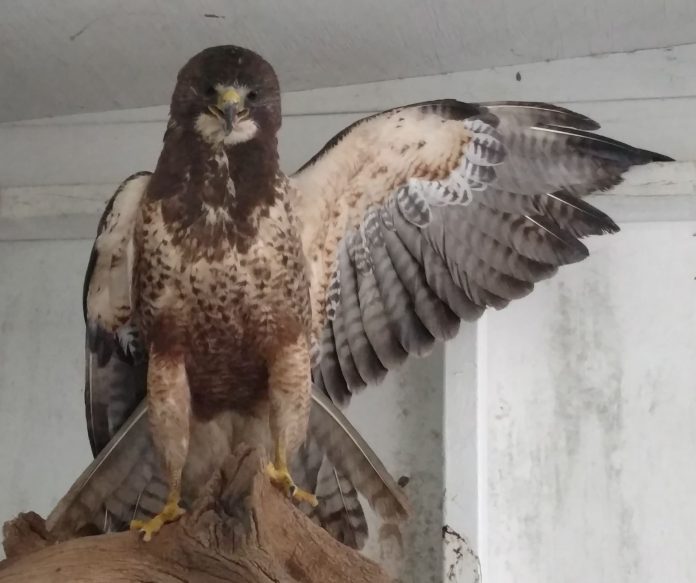
<
Even after 13 years of rehabilitating countless songbirds, raptors, reptiles and assorted mammals, there are still some “mystery critters.” Sometimes it’s because they’re too young to identify, other times because it’s such an unusual animal (to me or to our locality).
<
This hawk was found early in April by a rancher who saw it on the ground in his field for several days. He was finally able to capture it and transported it to the Wildlife Education and Rehabilitation Center (WERC) in Morgan Hill. The hawk was given an exam and treatment for a large swelling on its left wrist—fortunately not a fracture.
<
As we were filling out the acquisition form’s “species” line, our first impression was that it was a juvenile red-tailed hawk, a common bird in rehab and in the wild. But this hawk was just a little bit different, being somewhat smaller and with atypical coloring.
<
Photos were sent to an expert birder and the bird-of-prey was identified as a Swainson’s, a hawk rarely seen in Morgan Hill.
<
With medication, the hawk’s swelling subsided and he was placed in the 100-foot aviary to exercise and improve his strength. For a while, we were unsure of its flight capability, as one wing drooped slightly. We always ensure that a bird has perfect flight before being released, but it was especially important for this hawk because a Swainson’s migrates to South America for the winter, a distance of 6,000 miles.
<
While we fed the hawk up to eight small rodents a day, we were surprised to learn that Swainson’s also eat insects almost exclusively during non-breeding months. Crickets, grasshoppers (Swainson’s are sometimes called grasshopper hawks), dragonflies, butterflies, moths and beetles provide a banquet of protein and the hawks catch them “on the wing,” by running on the ground, or by hovering in the sky and scanning fields for prey.
<
There’s a good reason why we weren’t able to identify this hawk at first. It wasn’t until 2013 that a Swainson’s chick hatched in Santa Clara County’s Coyote Valley for the first known time since 1894. This year marks the fourth time that the pair of hawks has returned to this area to nest.
<
In 1979, only 350 pairs existed in California and the bird was listed as “threatened” under the California Endangered Species Act. There are now 2,250 pairs in the state. The resurgence can be credited to state protection, pesticide bans and protected habitat, according to De Anza College raptor biologist Ryan Phillips.
<
Your best bet for observing Swainson’s hawks is during summer in open country. They can be seen perching on utility poles, fence posts and in trees. In April and September, watch for soaring flocks of raptors—which can number in the hundreds—over open country, hitching a ride on the thermals. We are thrilled to report that WERC’s Swainson’s, in a perfect release near a wildlife refuge in Los Banos in June, will be joining them. Watch a video of the release at www.werc-ca.org.
<
Contact Colleen Grzan at we**@*****ca.org.
<
In 1979, only 350 pairs existed in California and the bird was listed as “threatened” under the California Endangered Species Act. There are now 2,250 pairs in the state.







